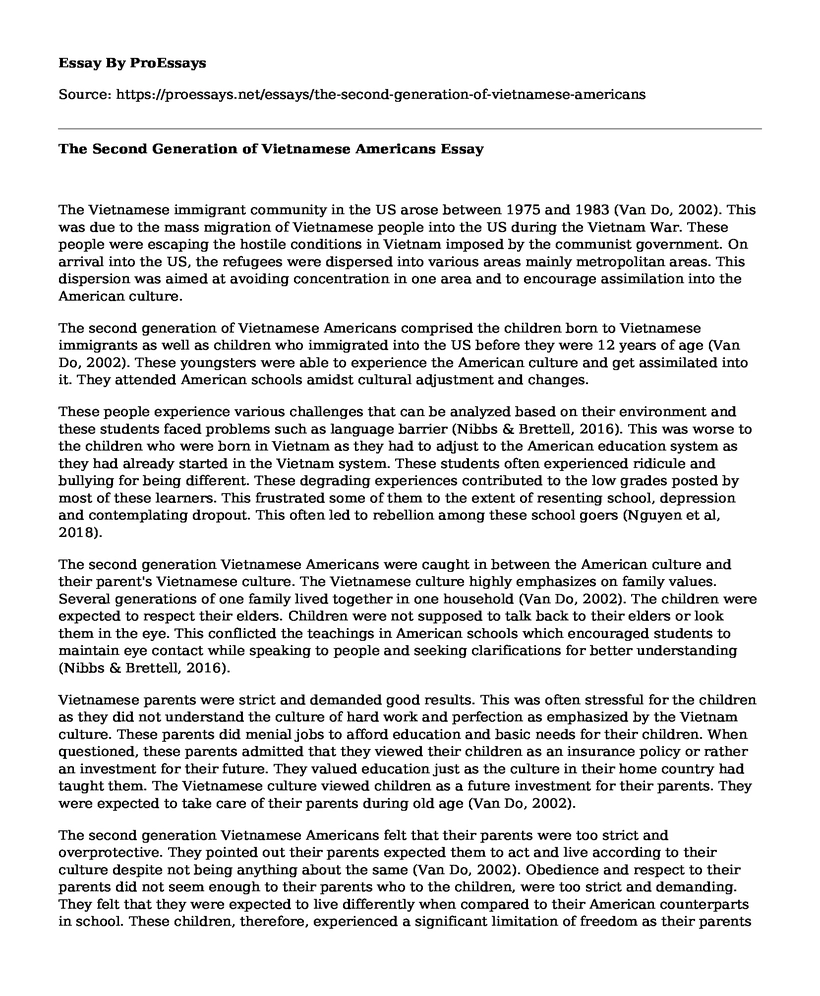The Vietnamese immigrant community in the US arose between 1975 and 1983 (Van Do, 2002). This was due to the mass migration of Vietnamese people into the US during the Vietnam War. These people were escaping the hostile conditions in Vietnam imposed by the communist government. On arrival into the US, the refugees were dispersed into various areas mainly metropolitan areas. This dispersion was aimed at avoiding concentration in one area and to encourage assimilation into the American culture.
The second generation of Vietnamese Americans comprised the children born to Vietnamese immigrants as well as children who immigrated into the US before they were 12 years of age (Van Do, 2002). These youngsters were able to experience the American culture and get assimilated into it. They attended American schools amidst cultural adjustment and changes.
These people experience various challenges that can be analyzed based on their environment and these students faced problems such as language barrier (Nibbs & Brettell, 2016). This was worse to the children who were born in Vietnam as they had to adjust to the American education system as they had already started in the Vietnam system. These students often experienced ridicule and bullying for being different. These degrading experiences contributed to the low grades posted by most of these learners. This frustrated some of them to the extent of resenting school, depression and contemplating dropout. This often led to rebellion among these school goers (Nguyen et al, 2018).
The second generation Vietnamese Americans were caught in between the American culture and their parent's Vietnamese culture. The Vietnamese culture highly emphasizes on family values. Several generations of one family lived together in one household (Van Do, 2002). The children were expected to respect their elders. Children were not supposed to talk back to their elders or look them in the eye. This conflicted the teachings in American schools which encouraged students to maintain eye contact while speaking to people and seeking clarifications for better understanding (Nibbs & Brettell, 2016).
Vietnamese parents were strict and demanded good results. This was often stressful for the children as they did not understand the culture of hard work and perfection as emphasized by the Vietnam culture. These parents did menial jobs to afford education and basic needs for their children. When questioned, these parents admitted that they viewed their children as an insurance policy or rather an investment for their future. They valued education just as the culture in their home country had taught them. The Vietnamese culture viewed children as a future investment for their parents. They were expected to take care of their parents during old age (Van Do, 2002).
The second generation Vietnamese Americans felt that their parents were too strict and overprotective. They pointed out their parents expected them to act and live according to their culture despite not being anything about the same (Van Do, 2002). Obedience and respect to their parents did not seem enough to their parents who to the children, were too strict and demanding. They felt that they were expected to live differently when compared to their American counterparts in school. These children, therefore, experienced a significant limitation of freedom as their parents always felt that they were being entrusted with too much independence.
Conclusion
The second generation of Vietnamese Americans was the first group to face the challenges of growing up in the American culture. They experienced problems assimilating the American culture which was mostly contradictory to that of their mother country. The language barrier, social and environmental circles as well as the traditional family values are some of the shortcomings they experienced while growing up in America.
References
Nguyen et al. (2018). Prospective Relations between Parent-Adolescent Acculturation Conflict and Mental Health Symptoms among Vietnamese American Adolescents. Cultural Diversity and Ethnic Minority Psychology, 24(2), 151.
Nibbs, F. G., & Brettell, C. B. (2016). Identity And The Second Generation: How Children Of Immigrants Find Their Space. Vanderbilt University Press.
Van Do, P. (2002). Between Two Cultures: Struggles of Vietnamese American Adolescents. The Review of Vietnamese Studies, College Park, Md.: U of Maryland, 2(1), 2-3.
Cite this page
The Second Generation of Vietnamese Americans. (2022, Mar 03). Retrieved from https://proessays.net/essays/the-second-generation-of-vietnamese-americans
If you are the original author of this essay and no longer wish to have it published on the ProEssays website, please click below to request its removal:
- Adult Development Plan
- Lifespan Development: Adolescence
- Relationship Between Brain Development and Adolescent Judgment and Risk Taking
- Racism, Colonization, and Civilization Essay
- Essay Example on Human Intelligence: A Controversial Topic for Centuries
- Essay Sample on Manliness & Race: A Historical Perspective on Civilization
- Essay Sample on Cradle of Civilization: Exploring 10000 Years of Mexican Culture







